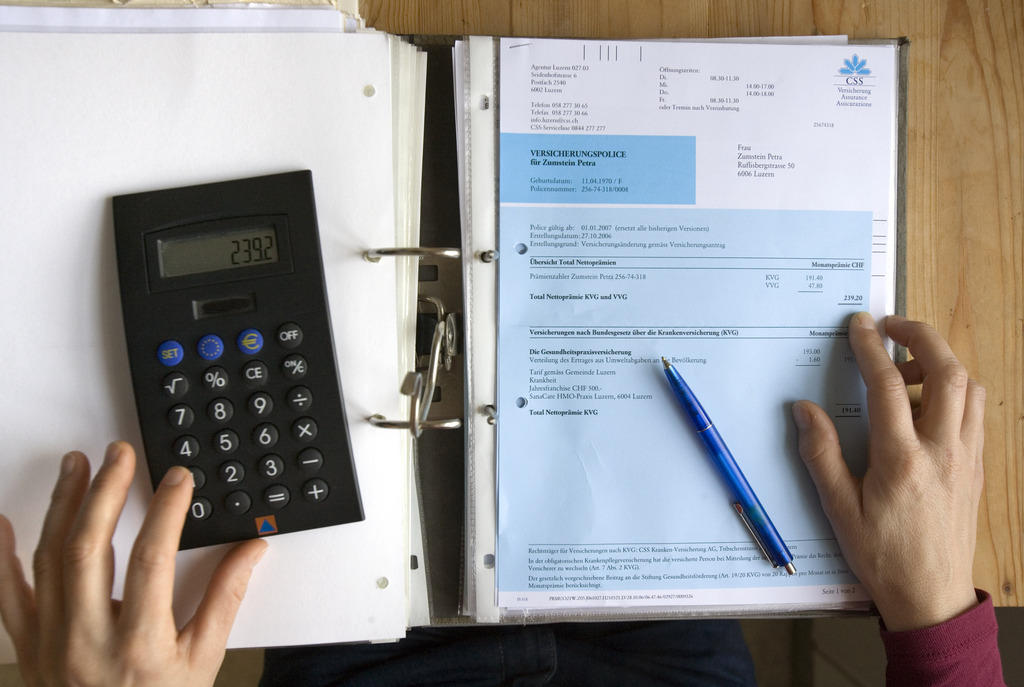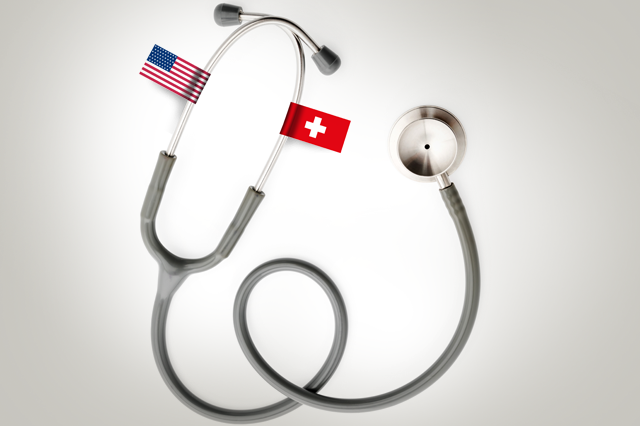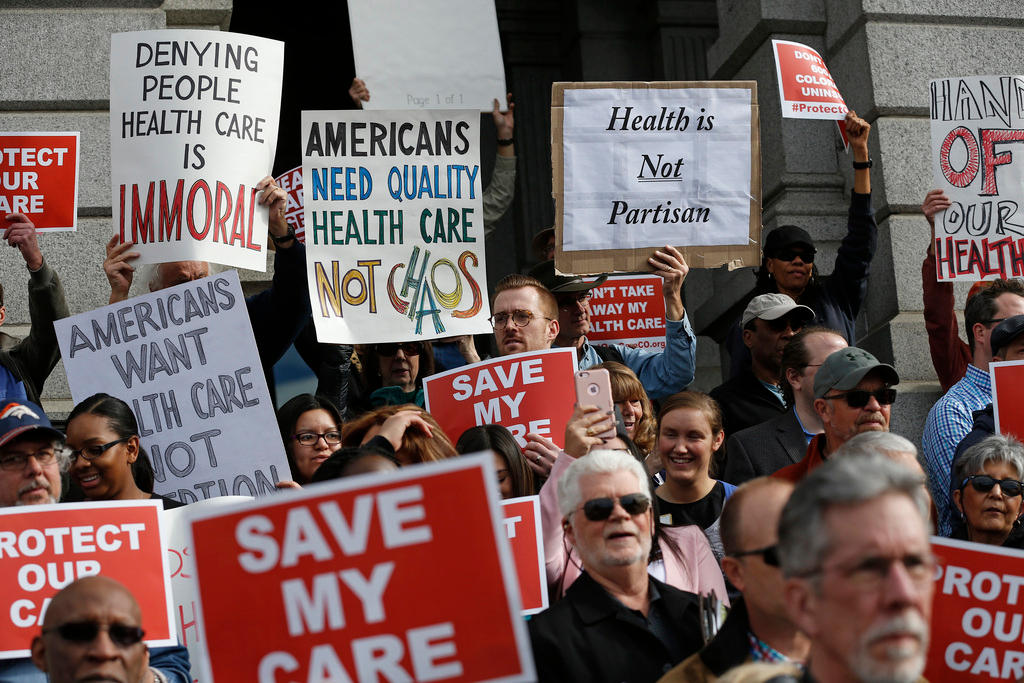
Do American and Swiss patients get what they pay for?

Health care doesn’t come cheap in the United States or Switzerland, and depending on your situation, the bill can vary widely. Are Americans and the Swiss getting top-quality care for their money?
Several readers wanted to know how much residents in the two countries pay for health care, in terms of public and private contributions, and whether the quality of care justifies the costs.
We’ve already given a primer on the health care systems in each country, and how many different insurance options US residents have depending on how much they make, what they do, and how old they are.

What does it cost, and why?
US healthcare spending is a whopping 17% of GDP, or more than $9,000 per capitaExternal link. (Some estimatesExternal link put the cost per person over $10,000). By comparison, Switzerland spends about 12% of GDP, at more than $6,300 per capita.
One reason for the higher cost in the US is that variety in coverage we mentioned before. With so many different insurance options and programs, there are lots of opportunities for increased administrative costsExternal link, and variety in how people might interact with health care services. It’s more expensive for someone to just go to an emergency room than deal with a doctor visit, for example. The EMTALA ActExternal link requires that the public have access to emergency care regardless of ability to pay. But that was meant to enable a patient to be stabilized and not as a general health care solution.

More
Two patchwork health care systems, and two stories of reform
The biggest reasons for higher health care costs in the US might be linked to two things: prices and patients.
In the US, procedures and pharmaceuticals are priced higher than in other parts of the world. For example, the average cost ofExternal link an MRI is $1,119 (CHF1,104), whereas in Switzerland the average is about half that at $503. A hip replacement will run you a cool $29,067 in the US, but a new Swiss hip will cost $17,112. If you need a C-section delivery in the US, your average cost is $16,106; in Switzerland, it’s $9,965.
Costs can also vary widely from hospital to hospital, or insurance company to insurance company. The prices for procedures and services are determined by a master list in a hospital, but the actual charges are often negotiatedExternal link with insurance companies. This moving target for prices, and the confusing world of codingExternal link, all contribute to higher costs.
Some in the US want to see a more assertive effort at cost controls, proposing a more direct federal price negotiationExternal link for pharmaceuticals for Medicare, a program for older and some disabled Americans. And some are still pushing External linkfor an expanded Medicare system to cover everyone in a single-payer-esque system, to exert more widespread pressure to cut costs. But that’s unlikely to happen anytime soon.

Who pays for the Swiss system?
In 2015, the Swiss state contributedExternal link CHF13.8 billion to the health care system, or 18% of the overall cost, which came to a whopping CHF77.7 billion. The rest was footed in part by compulsory basic health insurance (35%) and out-of-pocket payments by households (28%).
Put another way, the system cost each Swiss resident CHF782 per month.
So households bear a large brunt of the financial burden. That’s because in addition to basic insurance premiums, adults over 18 have “out-of-pocket” expensesExternal link in the form of cost-sharing fees, such as at least a standard CHF300 deductible, and a 10% retention fee on treatment costs after the deductible has been exceeded, up to a maximum of CHF700 per year. Some people also choose to take out supplementary health insurance at additional cost.
On top of that are medical expenses not covered by either basic or supplementary insurance. In a major 2016 surveyExternal link of patients’ experiences in 11 industrialised countries, Swiss respondents (46%) were more likely than others to have spentExternal link over $1,000 on such treatments or services in a single year.
Health care spending is expected to continue to rise in the coming years. And a recent report showed that more than 20% of Swiss residents decided not to see a doctor last year for medical treatment due to the high costs.

Do those costs add up to outstanding health care?
The general feeling in Switzerland is that these eye-watering costs, which tend to go up each year, prop up one of the best health care systems in the world. Some two-thirds (66%) of respondents to the International Health Policy Survey considered the quality of care to be excellent or very good, the highest rate among the 11 countries surveyed. A majority (59%) said that overall, the system performed well and only minor changes were needed. In the US, by comparison, that figure stood at 19%.
The US is still a top destination for medical innovation and cutting-edge technology. But its overall health indicators are poor.
Life expectancyExternal link for men is 76.3 years, compared to an OECD average of 77.9. For women, it’s 81.2 years, with an OECD average of 83.1. Life expectancy for Swiss men and women is closer to the OECD average (80.8 and 85.1, respectively).
The US has an infant mortalityExternal link rate of 6.1 deaths per 1000 births. For Switzerland it’s 3.9 deaths per 1,000 live births, and the OECD median is 3.5.
And the US has an obesity rate—as of 2012—of 35.3, compared to just 10.3 in Switzerland, and an OECD median of 28.3.
Obesity and other lifestyle factors also raise health care costs for Americans, as it increases the risk of expensive treatments External linkfor diabetes, heart disease, high blood pressure, and more.
Switzerland may perform better than the US on basic health indicators, but its results still mostly hover near the OECD average. In fact, some people in Switzerland are beginning to wonderExternal link if they’re really getting such great value for their hard-earned francs. The state-mandated price watchdog, for example, analysed health indicator dataExternal link and found Swiss hospital performance to be middling in key areas, such as mortality rates, post-surgery complications and waiting times for an operation. It concluded that the quality of care was average and did not justify the high costs.
The authors of the international survey made a similar assessment. After combining questionnaire results with health data from the WHO and OECD, it ranked Switzerland 6th in a comparison of health care system performanceExternal link in 11 industrialised countries. Tellingly, the country scores just 4th place for health care outcomes.
So, although a majority of Swiss appear to be satisfied with their health system, studies reveal they are getting good but not outstanding care, given the considerable sums they spend. And if you’re looking at cost as an indicator of quality, it appears the US is not getting what it’s paying for, either. That’s one of the big reasons the country is still grasping for health care reforms, but for now it’s slow going.
Ask a question about the Swiss and US health care systems and we may cover it in this series:

In compliance with the JTI standards
More: SWI swissinfo.ch certified by the Journalism Trust Initiative
















![The four-metre-long painting "Sonntag der Bergbauern" [Sunday of the Mountain Farmers, 1923-24/26] had to be removed by a crane from the German Chancellery in Berlin for the exhibition in Bern.](https://www.swissinfo.ch/content/wp-content/uploads/sites/13/2025/12/01_Pressebild_KirchnerxKirchner.jpg?ver=ebf28c90)















You can find an overview of ongoing debates with our journalists here . Please join us!
If you want to start a conversation about a topic raised in this article or want to report factual errors, email us at english@swissinfo.ch.